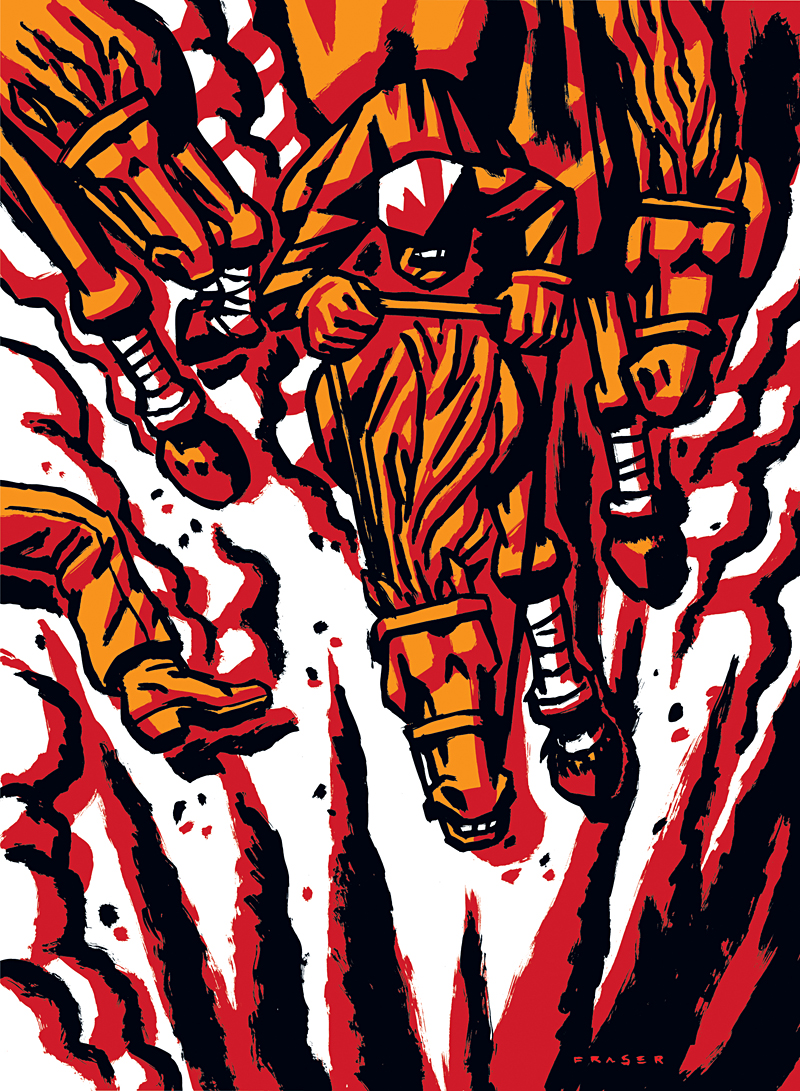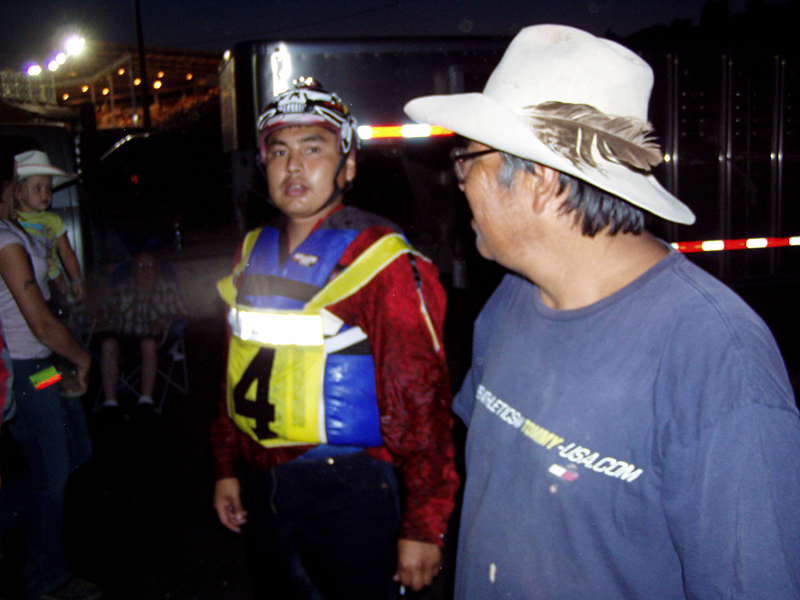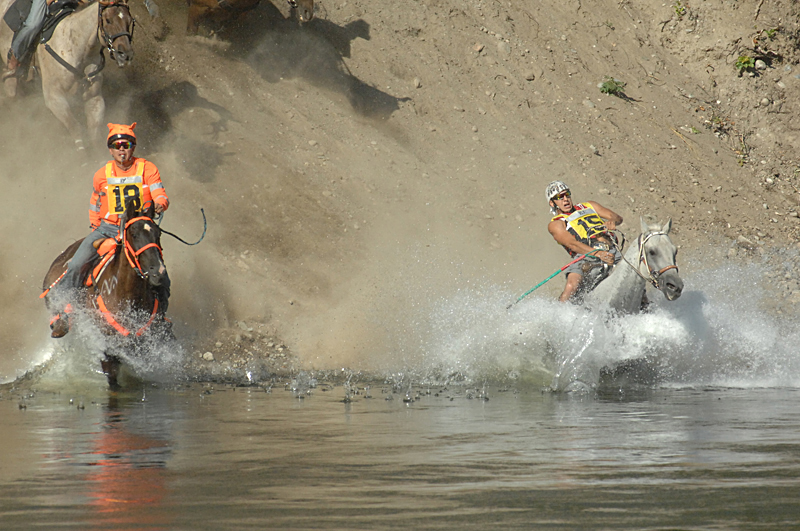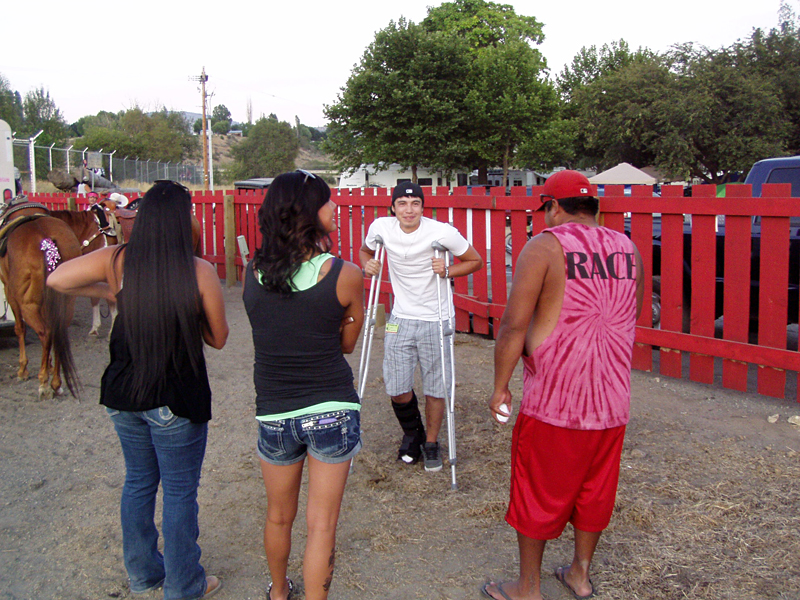Here’s how you race Death, Mike Harry is saying: Ride horse down hill, cross river, go into arena, receive applause, tip hat. Nothing to it, he says.
“But always say a prayer first, just in case.”
A short, barrel-chested 60-year-old member of the Colville Confederated Tribes and former Indian jockey, Mike is standing with his son Josh on a high bank over the narrow Okanogan River, which meanders along the Omak Stampede rodeo ground, a couple hours south of the Canadian border in north central Washington. The river moseys among the fruit orchards and cattle ranches of the dry, brown Okanogan Valley where, this August afternoon, the temperature is inching toward 90.
Mike is squinting against the sun and adjusting his glasses as he scans the hillside, down which Josh, a chubby-cheeked 25-year-old Indian horseman, will come careening and crashing the next evening with 19 other jockeys and horses in something called a Suicide Race.
“By the way,” Mike says, “I prayed for the horse, not me.”
Laughter comes from a few fans who have stopped to eavesdrop on the impromptu pre-race talk—early arrivals gathering beneath the hill, looking for someone who knows about the race. Mike, a rider, owner, and trainer for more than 40 years, answers their questions as workers ready the nearby 7,500-seat arena for the next night’s opening of the 78th annual Omak Stampede. The Professional Rodeo Cowboys Association event and multimillion-dollar boost to the local economy features bronco and bull riding, calf roping, chuck-wagon races, and a rip-roarin’ beer garden.
Still, the star attraction is the World Famous Suicide Race, the downhill madness started by a white Stampede PR man and hosted separately from the rodeo these days by a Native American horse and jockey association. It was inaugurated two years after the Stampede and held every year but one, when it was canceled in a dispute over revenues.
But Suicide Hill is not about money, Mike tells an inquiring fan. It’s tribal tradition, horse-warrior history. “Once you get in this kind of race, you can’t rest, your blood is boiling.” He nods to his son. “Tonight, he will be sleepless. Once that gun goes off, it’s you and your horse. Once you come off that hill and hit the water and start swimming, you know you’re a man.”
According to the rodeo’s literature, the hill race achieved its fame after it “was featured twice on TV’s You Asked for It [a popular 1950s reality show] and in dozens of newspapers” and in “a full-length Walt Disney movie, Run, Appaloosa, Run,” that starred young Casey Nissen, “a Suicide Race winner many times over.”
The race is as popular today thanks in part to a more negative image, typified by a popular YouTube video posted by the Humane Society of the United States that shows a thousand-pound horse sprawling on the hill in the midst of a race. The animal is spun around, then somersaults backward down the steep slope. The video, viewed more than 130,000 times, is titled “Horses Plunge to Death in ‘Suicide’ Race.” In a voice-over, Robert Reder of the Humane Society says horses are not built to endure the speed and impact of the downhill race. “It’s inhumane and it’s cruel,” he says.
That obviously has been the case for at least 22 horses whose Suicide Race deaths have been documented in recent years. Animal-rights groups say a horse dying in mid-race is part of the blood-sport attraction for fans, like NASCAR pileups and bench-clearing brawls. In this instance, it’s something akin to a Preakness run down Breakneck Mountain.
Says Beverly Larson of Portland, one of the tourists listening to Mike on the riverbank, “We love the Stampede, but we come for the Suicide Race. It usually lives up to its name.”
In the darkness of opening night, Mike’s son and the 19 other riders move atop their mounts along the crowded Stampede grounds, kicking up dust in car headlights and heading towards the Highway 97 bridge, where police and troopers have stopped traffic. Shortly, the line of clopping horses will cross the river and climb the far hill, circling back and turning down a dead-end residential street. They’ll arrive to a spot where another smaller crowd has gathered, on a ridge lined with homes opposite the Stampede grounds, overlooking the valley.
It’s near 10 p.m., and Mike and hundreds of others are squeezed along the riverbank, aided by a few pathway spotlights. Thousands more watch from the brightly lit grandstands about half a football field away. The racing, comprising mainly Indian horses and riders, is held on three nights and one final afternoon. The hill is partially lit, casting shadows across the course, and a big-screen TV in the arena gives the grandstand crowd a clearer look. Still, watching from the riverbank is like sitting on the sidelines, hearing the pop of the pads. Within a half-hour the crowd stirs to the distant whinny of horses arriving at the hilltop.
Ever the race ambassador, old Mike is telling a few tourists that you need a big-boned mount—preferably one of the wild mountain horses (or their offspring) that the Colville bands catch in the nearby hills—to get safely to the bottom of Suicide Hill. A horse can run down that hill but a man can’t, says Mike. Even moving cautiously down the 220-foot-long embankment of sand and dirt, a man will fall on his face. The hill is sloped at a 62-degree angle. You might as well be walking down the side of a building.
Crack! The starter’s gun pops. Out of sight from the crowd beneath the hill, the horses are off on a 100-foot running start. In seconds, streaking against the night sky, a mounted battalion suddenly appears in full gallop at the edge of Suicide Hill and begins cascading over the rim. The crowd collectively gasps, then roars.
Horses come snorting and flailing into the air, strung in a line as they clear the ridge and begin landing on the freshly groomed runway. Some animals go into a slow slide; a few land sideways and spin about, still moving down the hill. A pack of lead riders are knee-to-knee as the horses bang together and bounce off the side rail, the whole mess flowing lava-like toward the river.
Whips fly, and the helmeted riders, with life vests under their shirts, tighten their hold on the saddle grips. Half the pack is making a sure-footed gallop down to the river’s edge, where rescue teams hang back anxiously, idling in place on boats and Jet Skis. The Okanogan River sometimes runs high in August, up to six feet, but it is only four feet tonight, and horses can touch bottom. Mostly, at mid-river, they swim as they are trained to do.
“In the old days,” Mike shouts, “the course was lit with flares. It was like coming off the hill with your eyes closed!”
Some horses effortlessly leap from the bank and dive into the flowing Okanogan, running and swimming. Others hesitate and half fall in. Several dump their jockeys and splash into the black river atop one another. Horses and riders float around separately. The shore crowd cheers the thrashing and cursing.
A steady column of riders and mounts is able to swiftly cross to the other bank 150 feet away and, coming out of the water at a gallop, they rise one by one onto a sloping pathway, then dash the final 400 feet into the arena.
Mike starts jumping around. He’s spotted his son.
On his hand-painted helmet, Josh had attached a glowing red light that could be seen in the middle of the pack as the 20 horses and riders came slip-sliding down the hill and hit the water. The red light disappeared, could be seen moving under water, then disappeared again.
Now, as the line of horses barrels toward the arena, Mike sees the red light bouncing past.
“He made it!” Mike says, as if he didn’t expect it. “Josh finished!”
From the riverbank, Mike and the others can hear the arena crowd start to scream with delight. On the big-screen TV, the arena camera zooms in, and each rider, stretched high on his horse, seems to have the same look on his face: relief!
First comes Patch, a gray quarter horse ridden by Tyler Peasley, a three-time Suicide Race winner and Omak High grad. On his heels is rival Abe Gunlose, a wild man with a Jack Nicholson grin whose helmet is adorned with tribal feathers, atop Commando. A flurry of others follow closely.
Near the back of the galloping line of non-winners is Josh and his dappled gray, NDN Chrome. He blows past the finish and circles the arena waving.
He has no hat to tip, but he gratefully accepts the applause.
The race took all of one minute. But that wasn’t long enough for four riders who never made it past the river.
None of their mounts appeared seriously injured, though several horses were later found to be bruised and cut. The jockeys fared less well.
Loren Marchand, overall winner the past three years and the one to beat this year, was thrown into the river and stepped on. “I was underwater, and the horses came over the top of me,” the 23-year-old said later on crutches, his foot in a cast. He was able to remount his horse, but once out of the water, realized he’d had the wind knocked out of him. He got down and took a couple steps. “I knew then my foot was broken.”
Another rider suffered a broken jaw; a third broke an arm. One rider, back in the trailer compound, sat down and said, “I’m not taking my shoe off until I get home, because it’s going to blow up like a balloon.”
“Four teams dropped out?” asked Marchand, who, like many of the jockeys, rides year-round in Indian relays and other endurance horse races. “Too many rookie horses,” he said, “too many rookie riders”—one of them just 17.
Before the four-day event ended last week, another jockey broke his ribs, yet another his tailbone. Only eight horses and riders, of the original 20 entrants, were still competing on Sunday.
Not that it wasn’t competitive. Ex-champ Peasley and challenger Gunlose got into a saddle-to-saddle fight in the final race Sunday afternoon. Gunlose grabbed the bridle of Peasley’s horse, then slapped Peasley, who retaliated by using his whip on Gunlose.
But as Pete Palmer, the female director of the tribal Owners & Jockeys Association, would say, “There are no rules, once that gun goes off, until you hit the finish line.” Peasley was the overall winner and took home roughly half of the $29,000 purse.
All in all, “it was a great race,” Palmer said. “And no horses died.”
The official toll of 22 dead Suicide horses doesn’t include those who may have died in the half-century prior to 1983, the year when animal-rights groups began to keep count (no rider deaths have been recorded in modern times). Nor does it include horses whose deaths may have taken place quietly afterward and gone unannounced.
But the number does include Chavez, a horse owned by George Marchand, a revered family name around the Suicide compound. (George is Loren’s uncle.) His 7-year-old quarter horse broke its back in a 2007 elimination heat; Marchand later put Chavez out of his misery at home with a shotgun. He is the last horse known to have died as a result of the Suicide Race.
“He’s buried in my backyard,” says Marchand, 35, sitting outside his horse trailer, surrounded by friends in a race staging area near the arena. An owner and rider for 20 years, Marchand is part of an extended family of Suicide racers. His late father Jim raced here, as did his uncles, and now his nephews. All are members of the Colville federation, the 12 tribal bands on the 1.4 million-acre reservation that spreads across the Okanogan past Grand Coulee Dam and into Ferry County.
“My elders were my idols; they showed me the ropes,” he says. “There’s nothing like racing and there’s no race like this one. I had that drive to want to win—when I’m up there and the gun goes off, I think ‘I got to get to the front.’ That’s what I think. ‘I got to get to the front if I wanna win.’ I want to win it for my father.” He has, including winning the Suicide title two years in a row.
Another of his hill horses died as well, years earlier, also buried in the backyard of the home where Marchand formerly lived.
“A horse is just like a human being for me. It’s just like losing a friend or a relative. Your whole family knows the horse and cares how he is. After Chavez died, I liked to think my dad wanted him worse than me, that he’s up there riding him, in greener pastures.”
He got up and went over to his horse, Doc Winzer, getting ready to tape its ankles. “I think about this race 365 days a year,” Marchand says. “I dream about it, I worship it. You don’t just come here and dominate, you have to figure out how to win. People are buying faster and stronger horses because they want to win this more than anything. Yes, you have a lot of your money and time tied up in this and a short time to make something of it. But in the end it’s your horse and his welfare that matters.”
Animal-rights protesters have seen things differently in recent years, particularly after three horses died in the first race of the 2004 event. At the bottom of the hill, a horse in the middle of the pack stumbled into another mount and they both went over, suffering serious bone breaks. Both had to be euthanized. Seconds later, a third horse collapsed and died at the finish line, suffering apparent heart failure. A spokesperson for the Progressive Animal Welfare Society of Lynnwood (PAWS) called the race “an organized form of animal abuse.”
Protesters were out in force the following year, carrying signs and flooding race organizers and Omak city officials with e-mails and threats, including warning race officials they would form a human protest chain at the bottom of the hill. Though no horses died in the hill race in 2005, a rodeo horse died in front of the arena crowd, tripped by a rope and snapping its neck, sparking more reaction.
Among other arguments, demonstrators disbelieved claims by Marchand and other tribal members that a race dreamed up by a local furniture salesman was really part of the Colville heritage. According to a history of the event compiled by PAWS, the salesman, Claire Pentz, who was also the Stampede’s publicity man, launched the Suicide Race after failing to attract big crowds with boxing, stock-car racing, and trained zebras.
His inspiration was cross-country tribal races on horses bred to thrive on the hard, rocky desert terrain of eastern Washington—hardly comparable, PAWS says, “to flinging a long-legged thoroughbred or quarter horse down a 62-degree slope in the dark of night . . . The horses—many ‘on-loan’ for the event—have suffered heart attacks from over-exertion, broken bones from shocking collisions and tumbles, and even horrifying death by drowning.”
As well, “A native rite-of-passage traditionally refers to a ritual or ceremony indicating the transition from adolescence to adulthood. Historically, Suicide Race riders ages range from 18 to well into the 30’s. Many have ridden in the race year after year seeking cash and popularity, not cultural fulfillment.”
That historical view of the race remains posted on PAWS’ website. But PAWS, like other animal-rights groups, did not show up to protest in Omak this month—nor last year or the past several years. Their disappearance has been a dramatic change, race officials say.
“In recent years, we received 7,000 protest e-mails from PETA [People for the Ethical Treatment of Animals] and PAWS,” says Palmer, the Owners & Jockeys Club president. “This year, we got maybe 60. Every now and then a protest statement comes through, but it is nothing like it used to be.”
The turnaround, Palmer thinks, is in part due to the modifications her group has made to the course—improving the surface, widening the track at the bottom to eliminate a bottleneck, adding better lights and a rail. The association has also strengthened pre-and post-race veterinary checks and begun to scratch horses that seem balky or are reluctant to swim.
Palmer and some owners and riders also think the four-year stretch without a horse death has persuaded their animal-rights nemeses that the race has been made safer, and therefore unworthy of protest. That’s at least partially true, says Mark Coleman, community-relations manager for PAWS. “It’s extremely fortunate and lucky that they haven’t had any deaths recently,” he says. “Those, frankly, are the sort of things that do spur protests, and without deaths there will be less public reaction.”
The Humane Society and several other animal-rights groups did not respond to requests for comment, and Coleman says his and other groups have been concentrating more on other campaigns. “There are always things we believe in and only so many things we can do,” he says.
PAWS’ involvement in earlier years helped influence several race sponsors to back out, but there doesn’t seem the need for that now, Coleman notes. “Technology has changed things too—online protests are very effective these days, when the need arises.”
And, if only for now, horses are no longer dying in Omak, Coleman adds, “That’s the best outcome for everyone.”
So the Suicide Race will go on, still a dangerous run for horse and jockey and a thrill for fans. And it will go on, Mike Harry insists, for him as well.
He and son Josh, who are homeless and also care for one of Mike’s grandkids, bunk with another of Mike’s sons at his home down the road in the reservation town of Nespelem. Mike is out of work, gets a little government money, and spends much of his day with the horses, thinking about coming down that hill one more time, he says. Maybe next year.
“I work out, build muscle, and ride a lot. I get tuned up. Riding involves the whole body,” he says. “It’s in the blood.”
Mike lifts his gray tank top and exposes a wide scarlet scar that runs from below his beltline to the top of his stomach. Intestinal surgery, he says. Mike used to be married and he used to drink a lot. “I’m clean and dry 34 years, but still divorced.”
After the hospital, he recalls, he got around on crutches and a walker, and was off the horses for a year. Now he’s readying his comeback.
“How do I look?” he asks. “Almost in shape?” If he rides the Suicide Race again, he thinks he’d be the oldest rider ever. (Director Palmer agrees.)
He also would be racing against his son Josh, just as they did six years ago. Mike was 54 and Josh was 19. Neither won.
“We were knee to knee, coming down the hill. I was on Omak Bucks, and—who were you riding?” he asks Josh.
“Boo Boo.”
“Boo Boo!” says Mike, “His mom’s horse. She didn’t know nothin’ about it. We snuck Boo Boo over here. We told her about it a week later.”
That was one of the few times, Mike says, he didn’t finish a Suicide Race: His horse rolled on him coming off the hill. The horse was OK, but Mike was a little damaged and couldn’t ride. In the next race, Josh rode his dad’s horse, finishing out of the money, but finishing. “The horse was four years older than Josh,” says Mike.
Josh didn’t get beyond the first night this year, however. The owner of NDN Chrome pulled that horse and a second horse he was running, and went home. Both mounts were a little banged-up, says Josh, whose horse had a gash on a back leg.
“Holy cow, she’s a fucking tough horse, though,” says Josh of Chrome. “We got run over once we hit the water, but we came up and finished, that’s what’s important.”
The big race is next year, anyway, old Mike says. “Me and Josh, knee to knee again.”
Then, Mike adds, in six years, the grandson. “He’ll be 17 then. The three of us, knee to knee, down the hill. Like I said: in the blood.”











